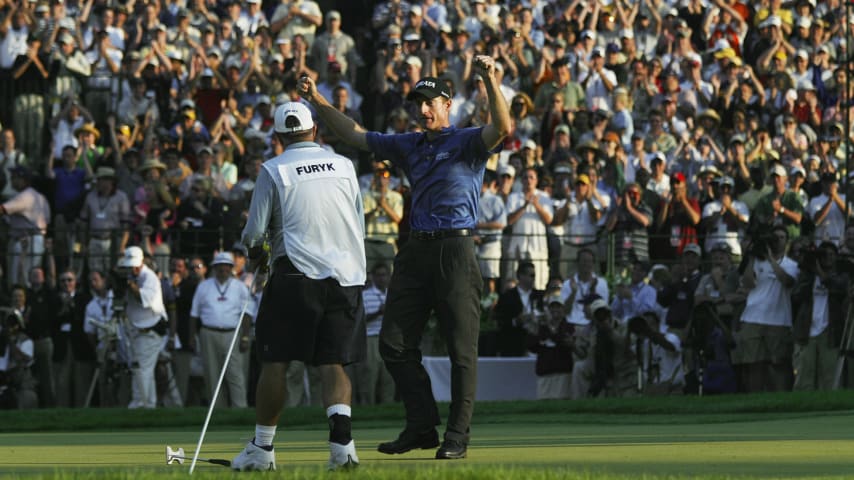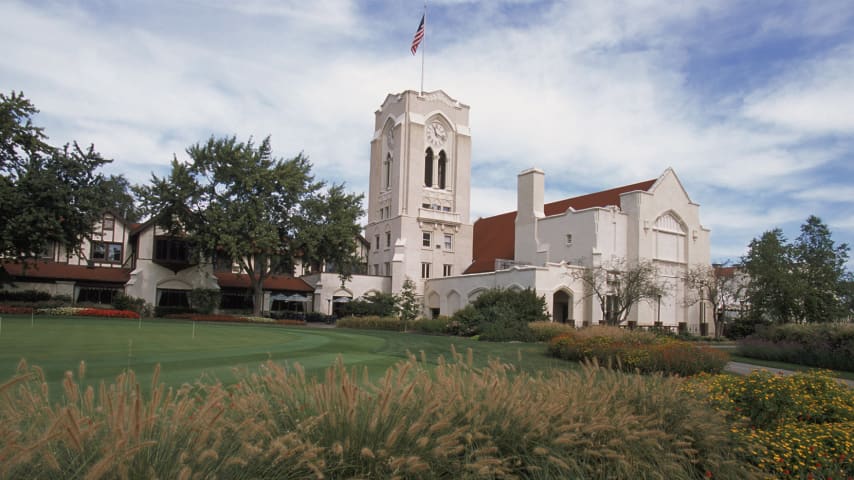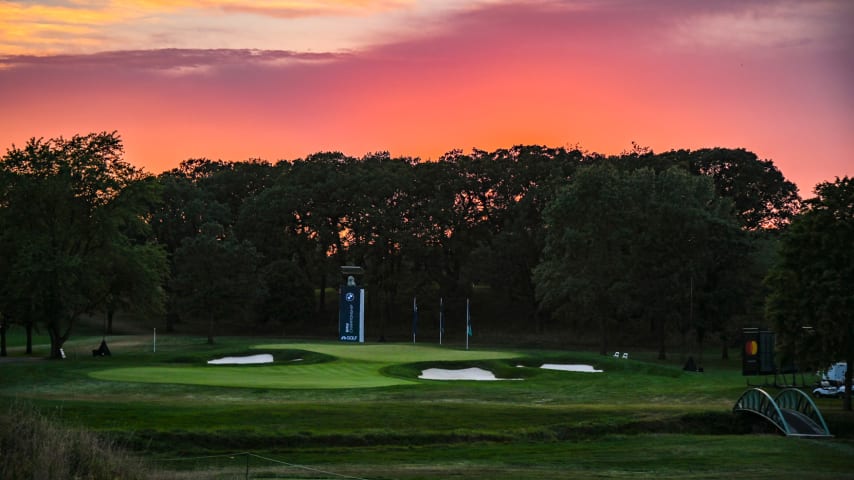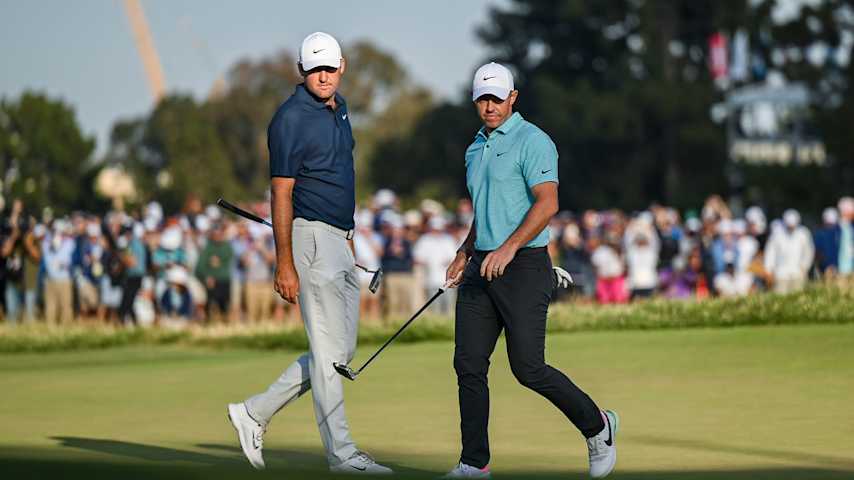Five things to know about Olympia Fields’ North Course
8 Min Read

Written by Bradley S. Klein
Most golf clubs have a 19th hole for gathering after a round. Olympia Fields has a 73rd. That’s because this property 35 miles south of downtown Chicago used to sport a quartet of 18-hole courses. It’s down to “only” 36 holes these days, but the legacy remains, as does the quality of shot-making demands.
Here are five things to know about Olympia Fields’ North Course, which is hosting the second stop in the FedExCup Playoffs, the BMW Championship, this week.
1. CHAMPIONSHIP PEDIGREE
When the top 50 players in the FedExCup tee it up at Olympia Fields’ North Course, they will be treading on hallowed ground. Big events have been played here over the past century, including two U.S. Opens (1928, 2003), a pair of PGA Championships (1925, 1961), the U.S. Senior Open (1997), U.S. Amateur (2015), the KPMG Women’s PGA Championship (2017) and the 2020 BMW Championship. The club also hosted one of the PGA TOUR’s foundational events, the Western Open, in 1920, 1927, 1933, 1968 and 1971.

Jim Furyk celebrates his final putt with caddie Mike "Fluff" Cowen after winning the 2003 U.S. Open on the North Course at the Olympia Fields Country Club. (Jonathan Ferrey/Getty Images)
The 1925 PGA Championship was the second of four consecutive PGA Championship victories for Walter Hagen. The 1928 U.S. Open is notable because dapper Johnny Farrell needed a 36-hole playoff to hold off Bobby Jones. Having already won that championship in 1923 and 1926, Jones went on to win it again in 1929 and 1930.
2. A LEGENDARY CLUB
In many ways, Olympia Fields set the tone for the sprawling, luxurious suburban country club when it was founded in 1915. The grounds are spread over 1,000 acres. With the opening of the North Course in 1923, the club came to include four 18-hole layouts, all starting and ending around the clubhouse with its iconic clocktower.

The club’s palatial clubhouse encompassed 110,000 square feet (2.5 acres) and, for decades, was the largest in the world. Its men’s locker room alone is 10,000 square feet – larger than many clubhouses these days. It is legendary for its distinctive rows of membership categories, including a whole section reserved for clergymen. In the 1920s, the club’s caddie yard swelled to 1,000 loopers on a busy day. Small wonder why the club enjoys its own eponymous train station on the Metra commuter line connecting its membership and employees directly to downtown.
When the enormity of the club became a financial burden in the early 1940s, Olympia Fields shed two of its golf courses for residential real estate. Parts of the first three layouts were folded into a new contiguous layout with returning nines that now serve as the club’s South Course. The integrity of the North Course has been kept intact since its opening in 1923.

Olympia Fields Country Club North Course | then and now
3. PARK’S PLACE
The North was designed by Willie Park Jr., a two-time winner of The Open Championship (1887, 1889) and a 2013 inductee into the World Golf Hall of Fame. He was born in 1864 in Musselburgh, Scotland, into a famous golfing family that included his father Willie Park Sr. (four-time Open Champion) and an uncle, Mungo Park, who also won The Open Championship. The Parks were the Edinburgh-area golf rival of Old and Young Tom Morris of St. Andrews. The two are the only father-son pairs enshrined in the World Golf Hall of Fame.
Park Jr. was a shrewd entrepreneur who parlayed his on-course success into a flourishing business – one that would become a model for successor celebrity golfers. He built golf clubs and golf balls that he shipped internationally, wrote two best-selling books – “The Game of Golf” (1896) and “The Art of Putting” (1920) – and designed over 170 courses across Great Britain, Europe and North America. Plagued by illness the second half of his life, he cut short an ambitious design tour of Canada and the U.S. in the early 1920s to return to Scotland, where he died in 1925 at age 61.
Park is among the underappreciated architects of the craft’s Golden Age. Despite his links heritage, he became a master of heathlands design, utilizing the native scrub and low-lying features of former farmland in and around London. Park called The North one of his greatest achievements.
"I have never seen a more natural setting for a championship course," Park said. "I am satisfied that your (North Course) is the equal of any golf course I have ever seen and I know of none that is superior, either in beauty or natural terrain."

His other two stellar examples of work that have held up are the Old Course at Sunningdale and Huntercombe, which features his characteristic mounding, inventively contoured greens and surprisingly sharp angles.
Much of this approach has been brought to new life in a restoration of Park’s Meadowbrook Country Club outside Detroit that Andy Staples undertook in 2017. Park’s other outstanding designs in North America are Maidstone Club on Long Island, Ottawa Hunt & Golf Club in Canada and Shuttle Meadow Country Club in Connecticut.
4. NORTH COURSE CHARACTER
Olympia Fields’ North Course is classic parkland Americana. Tree-lined and entirely landlocked, with interior views across the site thanks to sustained tree management that has opened views without denuding the terrain. It still feels tree-lined but it does not feel confined. The land rolls but does not undulate intensely, with only 42 feet of elevation change across the entire parcel.
The course offers greens of modest size – 5,240 square feet on average, all well protected by an average of three greenside hazards. The fairway acreage, 21 acres in total, is also relatively small in scale. Both numbers, by way of comparison, are about 15% smaller than Sedgefield Country Club, a classic Donald Ross design that hosted the recent Wyndham Championship.
With its tighter playing corridors and smaller, heavily-protected putting surfaces, the North Course requires very precise shot-making and is not easily picked apart. Jon Rahm’s winning score was just 4-under par in the 2020 BMW Championship and the average score was 71.8 – almost two full shots over par.
After a very dry spring at Olympia Fields this year – only 3.4 inches of rain fell from early April until late June – the skies have opened, dumping 9 inches of rain since. That means limited run on the fairways and extra thick rough that will be more difficult to recover from. At 7,343 yards, the par-70 North Course is not unduly long by modern championship standards. But it registers a slope of 150 from the back tees and a course rating of 76.6. Even with a field featuring the top 50 players in the FedExCup, par will be a terrific score.
5. HOLES TO WATCH
No. 1, par 5, 626 yards: Somewhat unusually, the course starts with its longest hole. This straightaway par-5 runs north along railroad tracks (thus its name, “Railroad”). With the prevailing southerly wind at the player’s back, many will be able to reach the green in two shots. One distinctive hazard along the way is a restored fairway bunker 300 yards out in the right rough – a doughnut bunker with a turf island, presumably representing the “O” for Olympia Fields.
No. 14, par 4, 450 yards: Easily the most memorable hole on the course and the most fraught with danger. The hole tumbles down from an elevated tee to a fairway enveloped by a dense, tree-lined corridor and a creek down the right side that runs across the far landing area, 330 yards out. The play here is generally a long iron or fairway metal off the tee for control, then an uphill, mostly-blind approach to a well-defended green with a considerable pitch from back to front. It’s one of those holes where you just play safe and try to get past without attempting to overpower it.
No. 15, par 5, 606 yards: This is the easterly counterpart to the preceding 14th hole, with dense woods lining the fairway and that creek now on the right side of the rough. The hole slides steadily uphill and to the right, with two fairway bunkers off the tee being the main obstacle to reaching the green in two shots – even when the prevailing wind is directly in your face. The entrance to this green invites a low running shot, which is why we can expect to see players coming at it with 3-woods and even drivers off the deck. Expect the occasional eagle – which could set up a very exciting finish.
No. 18, par 4, 498 yards: The North Course’s home hole has been the scene of some dramatic finishes, especially on the green. Jerry Barber holed putts from 20, 40 and 60 feet on the final three holes to send the 1961 PGA Championship to an 18-hole Monday playoff. That was also decided at the 18th green after January hit his approach into a bunker and could not get down. Barber two-putted for par from 18 feet to win his first (and only major) at age 45.

Billy Horschel on the 18th fairway at Olympia Fields. (Tracy Wilcox/PGA TOUR)
The BMW was contested without spectators in 2020, but the 18th green still provided magical theater. Having shot steadily improving scores of 75-71-66-64 to take a narrow final-round lead, Jon Rahm was staying loose at the range to prepare for a potential playoff. Dustin Johnson stood over a 43-foot, double-breaking putt over a hill that he needed to make to force extra holes. He made it, so it was off to a playoff at that same 18th hole when Rahm, now 66 feet away on a similar line to Johnson’s – but much farther back – snaked his putt in for the dramatic overtime win.

Jon Rahm’s 66-foot birdie putt to win playoff at BMW Championship
Somewhere the ghost of Jerry Barber was watching that 18th green.
Olympia Fields Country Club – North Course
Slope: 150
Rating: 6.6
| Hole | Par | Yardage | Name |
| 1 | 5 | 626 | Railroad |
| 2 | 4 | 467 | Crook |
| 3 | 4 | 461 | Ararat |
| 4 | 4 | 400 | Dardenelles |
| 5 | 4 | 417 | Narrows |
| 6 | 3 | 187 | Oasis |
| 7 | 4 | 452 | The Brook |
| 8 | 3 | 280 | Sunset |
| 9 | 4 | 472 | Halfway |
| Par | 35 | 3,762 | |
| 10 | 4 | 444 | The Carry |
| 11 | 4 | 396 | Woodland |
| 12 | 4 | 389 | Channel |
| 13 | 3 | 168 | Baby |
| 14 | 4 | 450 | Caution |
| 15 | 5 | 606 | Wilderness |
| 16 | 3 | 215 | The Pool |
| 17 | 4 | 455 | Two Rivers |
| 18 | 4 | 498 | Home |
| Par | 35 | 3,591 | |
| Total | 70 | 7,353 |





